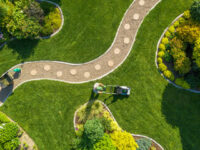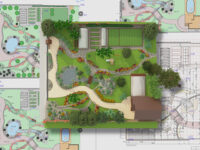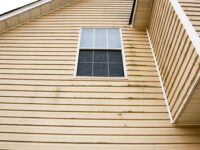Landscaping 101 – The Elements of Landscaping
Landscaping is the practice of creating an aesthetic, usable outdoor space. It includes adding or removing plants, changing the terrain, and constructing structures.
Landscaping Baltimore shows buyers that the owners take pride in their property and can increase the sale price. Plus, it’s a healthy activity that reduces stress and provides exercise.
Incorporating greenery in landscaping is one of the best ways to improve curb appeal and create a welcoming environment for visitors to your home or business. Studies have shown that people are more relaxed and happy when surrounded by greenery and natural elements. Green spaces also provide a natural escape from the hustle and bustle of everyday life, helping to ease stress and anxiety.
The most important aspect of green landscaping is using plants that are native or at least well-adapted to your climate. This helps to reduce water consumption, soil erosion and pollution. It also promotes biodiversity by attracting wildlife and preserving existing species. In addition, the use of grass and trees helps to shade buildings, reducing energy costs and the need for air conditioning.
Many landscapers offer a variety of green services that can be used to help you achieve your desired aesthetic. These include planting and maintenance, garden design, sod work, driveway interlocking, retaining walls and more. If you are looking to increase the greenery on your property, it’s important to communicate your vision to the landscaper so they can help you achieve it.
Another key element of green landscaping is the use of sustainable practices. This includes the use of recycled or repurposed materials, organic mulch and reduced water usage. For example, instead of bagging your lawn clippings, let them fall to the ground where they will decompose and add nutrients to the soil. You can also buy mulch in bulk to cut down on waste and save money.
Landscaping plays a vital role in supporting sustainability by enhancing the natural beauty of your property and increasing its value. In addition, it provides a number of health and environmental benefits, including improving air quality, reducing stress and anxiety, and increasing productivity. By utilizing the services of a professional landscaper, you can create an attractive and functional outdoor space that will make your home or business more appealing to potential buyers. In fact, top real estate agents across the country agree that homes with professionally-designed landscapes sell for 20% more than those without.
Form
The form of landscaping is the three-dimensional quality that defines the overall design theme. This can be influenced by the shapes of plants and the hardscape additions like walkways, patios and retaining walls.
The forms of these components can make your yard look more formal or informal. Rectilinear shapes create a formal look while circles and irregular shapes feel soft or natural. Plants also have their own individual form that may be pyramidal, vase-like or flat. These individual form characteristics are combined to create a design theme that is unique to your home.
Color is the element that attracts attention, so it’s important to choose flowers and plants that will provide colors throughout the seasons. Color also helps to tie the landscape together by establishing a visual theme. Theme ideas can be taken from the architecture of your house, a style you like, or from natural features in your area. Themes can also be applied to the different planting styles, such as grassland, tropical or desert.
Texture is a visual quality that describes how smooth or rough a plant or hardscape surface is. It also determines how heavy or light the landscape feels. It’s important to use texture to balance the form of your plants, hardscape and other design elements.
Lines are used to monitor and control movement in the landscape. They can be straight or curved and are often used around water features like fountains, ponds and swimming pools to reinforce the radial movements of these elements. Curved lines also are common in flower beds and walkways to create focal points that draw the eye.
If the work performed by a landscaper is considered to be a capital improvement, it should not be subject to sales tax. To qualify as a capital improvement, the work must add significant value or prolong the useful life of the real property. Typically, the work must be permanently affixed to the property and cannot be removed without substantial harm to it or the property owner.
Having attractive and well-maintained landscaping is one of the best ways to increase your property’s resale value. In fact, top real estate agents across the country agree that a well-planned landscape is the first thing a buyer notices about your home.
Color
Color is perhaps the most noticeable element of any landscape. It can draw attention to a focal point or help a garden appear larger or smaller. It can also add warmth or coolness and create a specific mood or feeling. For example, red evokes excitement while blue suggests calmness. While the color of a flower may last only a few weeks each year, the foliage of plants can add color throughout the entire year.
When selecting colors for the landscape, it’s important to consider how they interact with one another. Many homeowners choose a single flowering plant and then find a shrub or ground cover that complements it. This way, the overall design of the yard will be cohesive and aesthetically pleasing.
It’s also a good idea to keep in mind that some colors are more suited for certain seasons than others. For instance, bright and saturated flowers can be overwhelming at certain times of the year. On the other hand, a shaded or muted flower can work well during those times.
Besides using the color of plants, it’s also important to use color in the hardscape elements of the yard. For example, if the house is painted a certain color, it’s a good idea to repeat that hue in the landscaping around the home to create a seamless, appealing design.
A landscaping designer will often work with a color wheel to help create a cohesive look and feel for the landscape. This design graphic shows how primary and secondary colors interact and identifies which are warm or cool. Warm colors such as red, orange, and yellow tend to pop more and create excitement in the landscape while cool colors like blue and green blend into their surroundings and provide a calming feel.
In addition to the warm and cool colors, a designer can also use tints and shades of each color. A tint is a light version of the color made by adding white. A shade is a darker version of the color and can range from lavender to maroon.
When choosing colors for the landscape, it’s a good idea to take a drive around the neighborhood and observe the landscaping of other homes in the area. Pay special attention to the colors that attract you and try to figure out why they work so well. It’s also a good idea to look at photos of other landscapes in magazines and books to see what colors appeal to you.
Lines
Lines are one of the four main components of landscape design, along with shape, color, and texture. They are found in both the softscape (garden plants) and hardscape (hard, manmade features). In landscaping, lines can be straight, curved, vertical or diagonal. They can create a sense of movement or direction, accentuate focal points and define areas. They can also add contrast to a garden or landscape by creating a visual balance between the angular and straight lines of hardscape and the rounded, flowing lines of softscape.
While there are many different types of lines, the simplest and most common are straight lines. They are most often used in formal, symmetrical garden designs. Straight lines are also frequently found in the edges of walkways and the edges of hardscape materials. Straight lines can be broken up by using plants that spill over them. For example, a flowering vine that hangs over a pathway will soften the sharpness of the line and make it more pleasing to the eye.
Curved or circular lines can help balance the straight, angular lines of a house or structure. They can also be used to soften the sterile feel of a formal garden or accentuate an informal one. You can use circular lines in your garden by choosing a circular walkway or placing a circular planter in the center of a courtyard. You can also use them in the form of curved garden pathways, round hedges and flowers or in a gazebo or other structure with vine-covered walls.
Vertical lines can create more excitement in a garden by moving the eye up to the skyline or to the top of a tree canopy. They can also be created by using narrow tall trees like Polyalthia or bottle palms, trellis structures, and other tall ornamentals in a garden.
Long views are important landscape lines that create an illusion of space and can heighten the feeling of arrival when a visitor reaches their destination, whether it’s a main outdoor seating area at a public park or the entrance to a private residence. They can be achieved by planting trees and shrubbery in a straight line or in a circle, or by including other linear elements like a sloping masonry wall.





